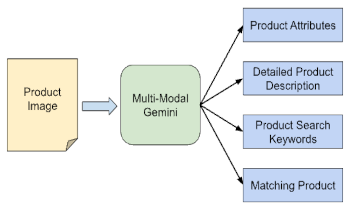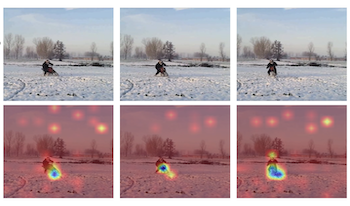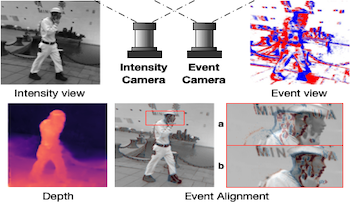
We present the application of a Multimodal Large Language Model, specifically Gemini, in automating product image analysis for the retail industry. We demonstrate how Gemini's ability to generate text based on mixed image-text prompts enables two key applications: 1) Product Attribute Extraction, where various attributes of a product in an image can be extracted using open or closed vocabularies and used for any downstream analytics by the retailers, and 2) Product Recognition, where a product in a user-provided image is identified, and its corresponding product information is retrieved from a retailer's search index to be returned to the user. In both cases, Gemini acts as a powerful and easily customizable recognition engine, simplifying the processing pipeline for retailers' developer teams. Traditionally, these tasks required multiple models (object detection, OCR, attributes classification, embedding, etc) working together, as well as extensive custom data collection and domain expertise. However, with Gemini, these tasks are streamlined by writing a set of prompts and straightforward logic to connect their outputs.

Pre-trained vision-language models, exemplified by CLIP, have exhibited promising zero-shot capabilities across various downstream tasks. Trained on image-text pairs, CLIP is naturally extendable to video-based action recognition, due to the similarity between processing images and video frames. To leverage this inherent synergy, numerous efforts have been directed towards adapting CLIP for action recognition tasks in videos. However, the specific methodologies for this adaptation remain an open question. Common approaches include prompt tuning and fine-tuning with or without extra model components on video-based action recognition tasks. Nonetheless, such adaptations may compromise the generalizability of the original CLIP framework and also necessitate the acquisition of new training data, thereby undermining its inherent zero-shot capabilities. In this study, we propose zero-shot action recognition (ZAR) by adapting the CLIP pre-trained model without the need for additional training datasets. Our approach leverages the entropy minimization technique, utilizing the current video test sample and augmenting it with varying frame rates. We encourage the model to make consistent decisions, and use this consistency to dynamically update a prompt learner during inference. Experimental results demonstrate that our ZAR method achieves state-of-the-art zero-shot performance on the Kinetics-600, HMDB51, and UCF101 datasets.

Event cameras are novel bio-inspired vision sensors that output pixel-level intensity changes in microsecond accuracy with high dynamic range and low power consumption. Despite these advantages, event cameras cannot be directly applied to computational imaging tasks due to the inability to obtain high-quality intensity and events simultaneously. This paper aims to connect a standalone event camera and a modern intensity camera so that applications can take advantage of both sensors. We establish this connection through a multi-modal stereo matching task. We first convert events to a reconstructed image and extend the existing stereo networks to this multi-modality condition. We propose a self-supervised method to train the multi-modal stereo network without using ground truth disparity data. The structure loss calculated on image gradients is used to enable self-supervised learning on such multi-modal data. Exploiting the internal stereo constraint between views with different modalities, we introduce general stereo loss functions, including disparity cross-consistency loss and internal disparity loss, leading to improved performance and robustness compared to existing approaches. Our experiments demonstrate the effectiveness of the proposed method, especially the proposed general stereo loss functions, on both synthetic and real datasets. Finally, we shed light on employing the aligned events and intensity images in downstream tasks, e.g., video interpolation application.

Event cameras are novel bio-inspired vision sensors that output pixel-level intensity changes in microsecond accuracy with high dynamic range and low power consumption. Despite these advantages, event cameras cannot be directly applied to computational imaging tasks due to the inability to obtain high-quality intensity and events simultaneously. This paper aims to connect a standalone event camera and a modern intensity camera so that applications can take advantage of both sensors. We establish this connection through a multi-modal stereo matching task. We first convert events to a reconstructed image and extend the existing stereo networks to this multi-modality condition. We propose a self-supervised method to train the multi-modal stereo network without using ground truth disparity data. The structure loss calculated on image gradients is used to enable self-supervised learning on such multi-modal data. Exploiting the internal stereo constraint between views with different modalities, we introduce general stereo loss functions, including disparity cross-consistency loss and internal disparity loss, leading to improved performance and robustness compared to existing approaches. Our experiments demonstrate the effectiveness of the proposed method, especially the proposed general stereo loss functions, on both synthetic and real datasets. Finally, we shed light on employing the aligned events and intensity images in downstream tasks, e.g., video interpolation application.